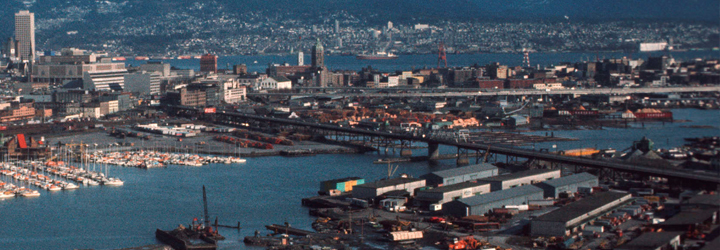

Northeast False Creek has a long history as a vibrant, active space used for cultural gatherings and activities. Connected to neighbouring Chinatown, it was part of the Coast Salish Empire and the heart of Vancouver’s black community along Hogan’s Alley.
In 1915, the original Georgia Viaduct was built to bypass the tidal waters, rail lines, and industry lands below. The Georgia Viaduct was replaced and twinned with the Dunsmuir Viaduct in the early 1970s as the first piece of a proposed freeway system that was planned but never built.
Since the 1960s, the area has changed significantly, and the viaducts have become both physical and visual barriers.
Historical timeline of the area
-
Pre 1850
Fraser Valley home to about 20 First Nation bands who made up the Sto:Lo Nation, or "People of the river"
-
1886
Vancouver incorporated
-
1887
The first CPR transcontinental passenger train reaches Vancouver
-
1890-1920
Chinese immigrants settled in Shanghai and Canton alleys
-
1890
Shanghai Alley home to more than 1,000 Chinese residents
-
1915
Original Georgia Viaduct complete
-
1920
False Creek is an industrial hub, ringed with sawmills, beehive burners, and brick stacks
-
1965
Georgia Viaduct replacement approved
Freeway fight: A six-lane freeway proposed to go through Vancouver
-
1967
Hogan's Alley (home to many immigrant communities) levelled to construct a freeway
-
1968
Freeway fight: Council cancels plan for freeway
-
1972
Construction of new Georgia Viaduct
-
1983
BC Place opens
-
1985
Science World opens
-
1986
Plaza of Nations opens
Dr. Sun Yat Sen Gardens opens
SkyTrain opens with Stadium Station located by Rogers Arena
Expo 86
-
1990
Gay Games III "Celebration 90"
-
1990-1994
Molson Indy
-
1993
Andy Livingstone Park opens
-
1994
Rogers Arena opens
-
1999
International Village opens
-
2004
Downtown Skateboard Plaza opens
-
2008
International Village neighbourhood complete
-
2010
2010 Winter Olympics and Paralympics
-
2013
Walk for Reconciliation
-
2015
FIFA Women's World Cup
-
2016
Rugby Sevens
